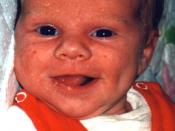Treating a person that is sick has never really been a question or a moral dilemma, until now. Infants born at the borderline of viability are born premature at 22 weeks. They can survive with the proper treatment; however, they are more likely to have a handicap of some form. Each situation differs as each child's will to survive, and each parent's will to learn is different. Survival also depends on where they are born. If they are born in Japan, they have a 30% survival rate; born in England, none. England argues that an infant born before 22 weeks is not even an infant. They argue this because only one percent of the infants born between 22 and 23 weeks survive long enough to leave the hospital; they believe that starting aggressive treatment on an infant with next to no chance to survive is wrong. If they are born in The United States of America or Canada, they fall somewhere in between.
HealingWell.com reports that the cost to care for a normal full-term infant is estimated around $2,830 in the first year of life (2005.) That cost more than quadruples to $41,610 dollars, when caring for a preemie (HealingWell.com, 2005). The toll that these kinds of situations take on families has many questioning if any of the care is even going to be worth it in the end.
The dilemma in treating them stems from survival. Micro-preemies are more likely to be left to die than older children or adults with the same set of disabilities. The reasoning behind this is because many parents feel the survival of a severely handicapped infant is worse than death. Neonatologists also experience guilt and moral dilemmas in that they feel for the parents of a neurologically traumatized infant.
The moral...


